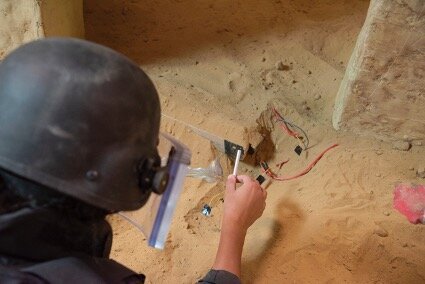GICHD IED Clearance Good Practice Guides
BACKGROUND
In September 2019 Artios was contracted by the Geneva International Centre for Humanitarian Demining (GICHD) to develop a series of draft Improvised Explosive Device (IED) clearance Good Practice Guides. After extensive input and review from across the Mine Action sector these guides were published by GICHD in December 2020.
The GICHD IED clearance Good Practice Guides have been developed with the aim of sharing information from across the Mine Action (MA) sector to assist in safe, effective and efficient IED search and disposal activities as part of a broader MA IED clearance process.
THE CHALLENGE
There has been a clear global trend over the last decade of IEDs resulting in more civilian casualties than commercially manufactured landmines. This has been particularly true in conflict affected states such as Afghanistan, Yemen, Syria and Iraq.
One of the visual aids developed for the Guides.
Based on GICHD’s field research, Artios was tasked to draft guides that would add meaningful value to the management of IED survey and clearance operations, assist in conducting technical field level search and disposal tasks, and to support Explosive Ordnance Risk Education (EORE) programmes. Potential users included National Mine Action Authorities; organisations implementing survey and clearance operations; and organisations delivering training. The guides were specifically intended to provide technical content related to specific IED clearance techniques and procedures, but without the intention of replacing formal training.
OUR ROLE
One of the graphical illustrations developed for the Guides.
Artios followed a defined Document Development Life Cycle to provide structure to the development of the material and enable revisions to be controlled. This structure ensured that the visual aids that were developed would be effective in engaging with the user to help show and not just tell. These visual aids were deliberately developed to illustrate a range of environments to provide a global context.
Our team of technical Mine Action IED clearance experts were supported by a number of organisations and individuals. Particular mention goes to Sync Imaging, Alford Technologies, Paul Elliott (for graphical illustrations), James Fidell, and Gareth Collett at Brimstone Consulting.
RESULTS
The GICHD IED clearance Good Practice Guides have already been trialled in Afghanistan and Yemen, where vital lifesaving training to both National Authorities and operational implementers is already showing indicators of early success. Hopefully this potential will now set the conditions for widespread sharing and the further adoption of IED clearance good practices, both in the development of National Standards and operationally in the field.
The GICHD IED Clearance Good Practice Guides are available here: https://www.gichd.org/en/our-response/mine-action-standards/improvised-explosive-device-clearance-good-practice-guide/
With special thanks to:
GICHD Urban Project Team
Swiss Federal Department of Foreign Affairs
German Federal Foreign Office
US Department of State
Brimstone Consulting
Alford Technologies
Sync Imaging
Contributors and peer review from across the Mine Action sector



